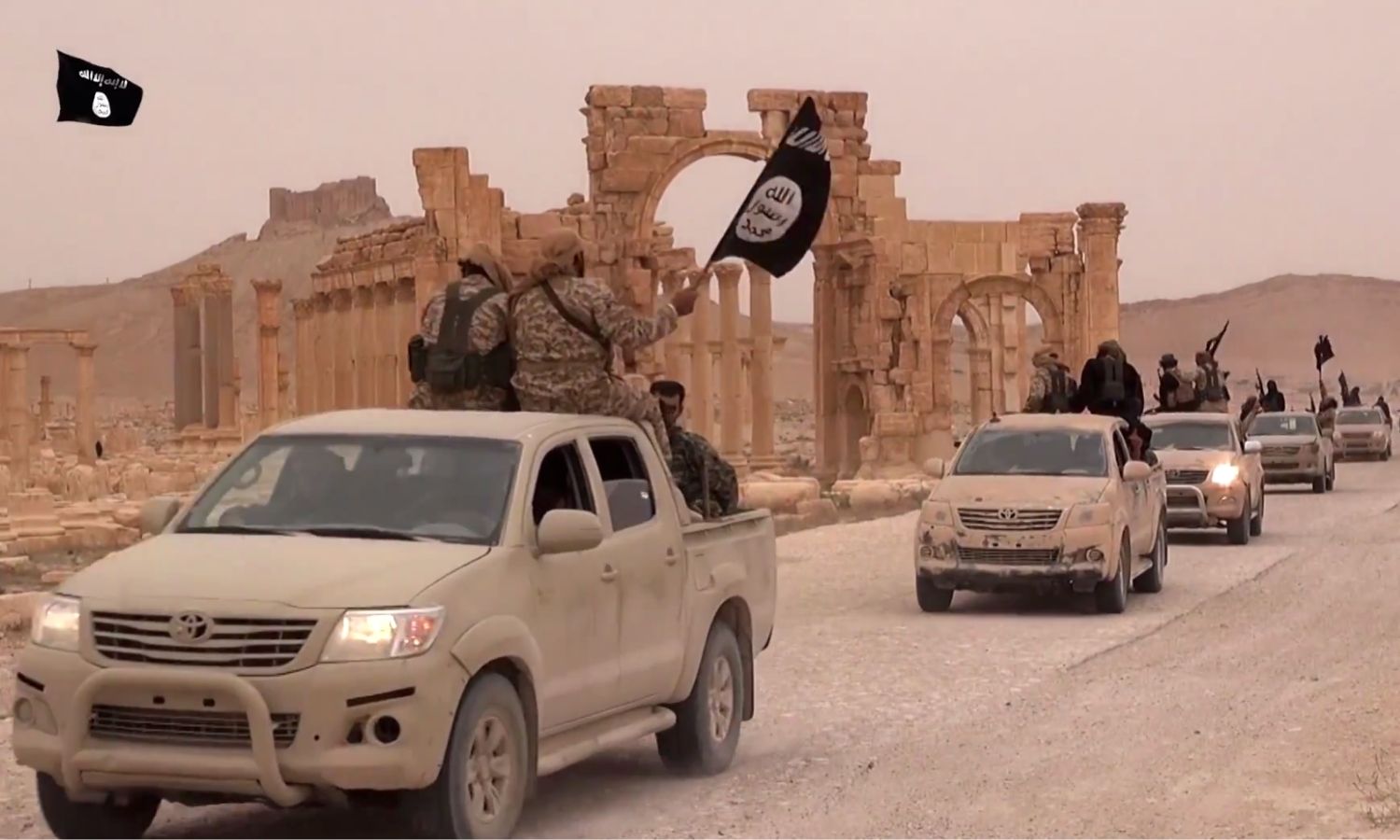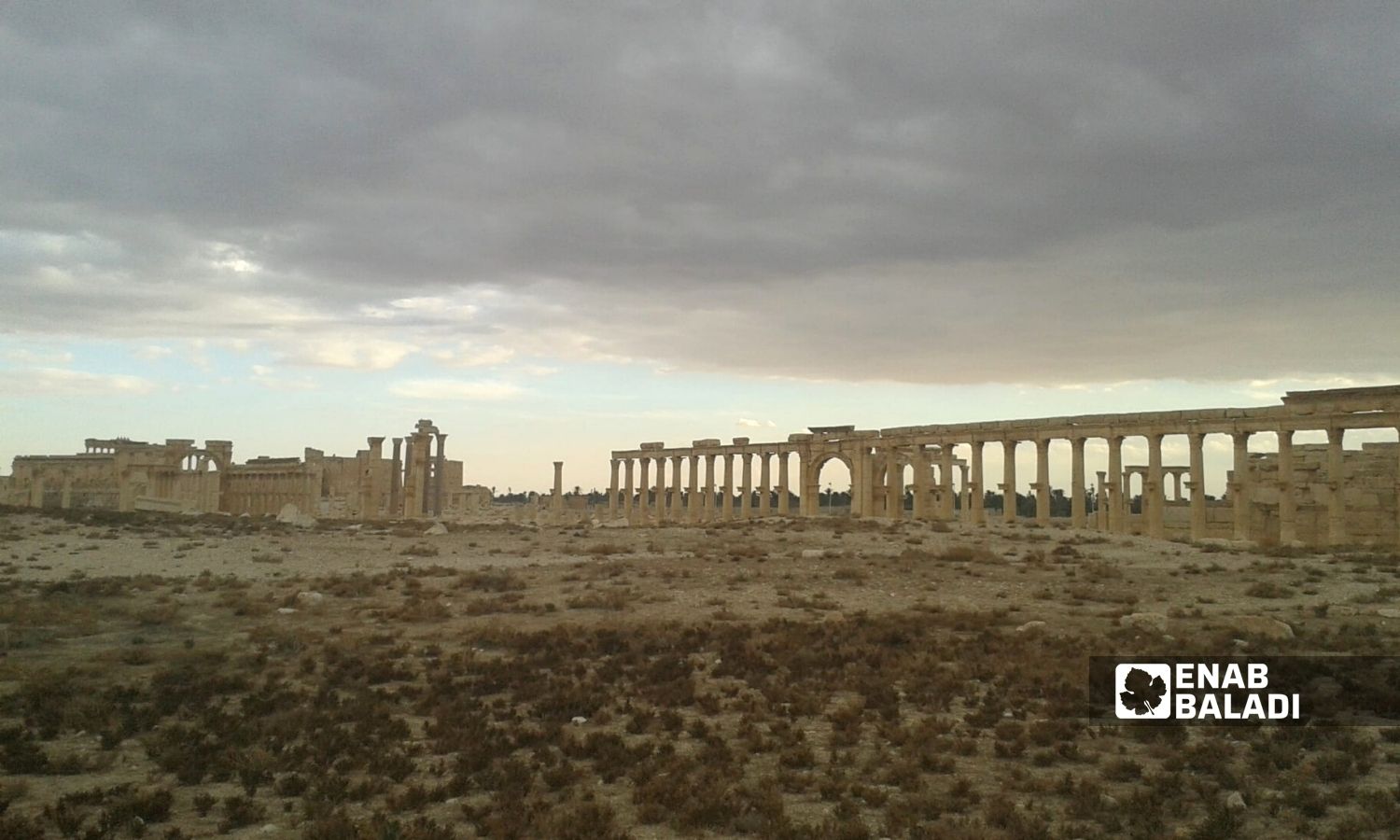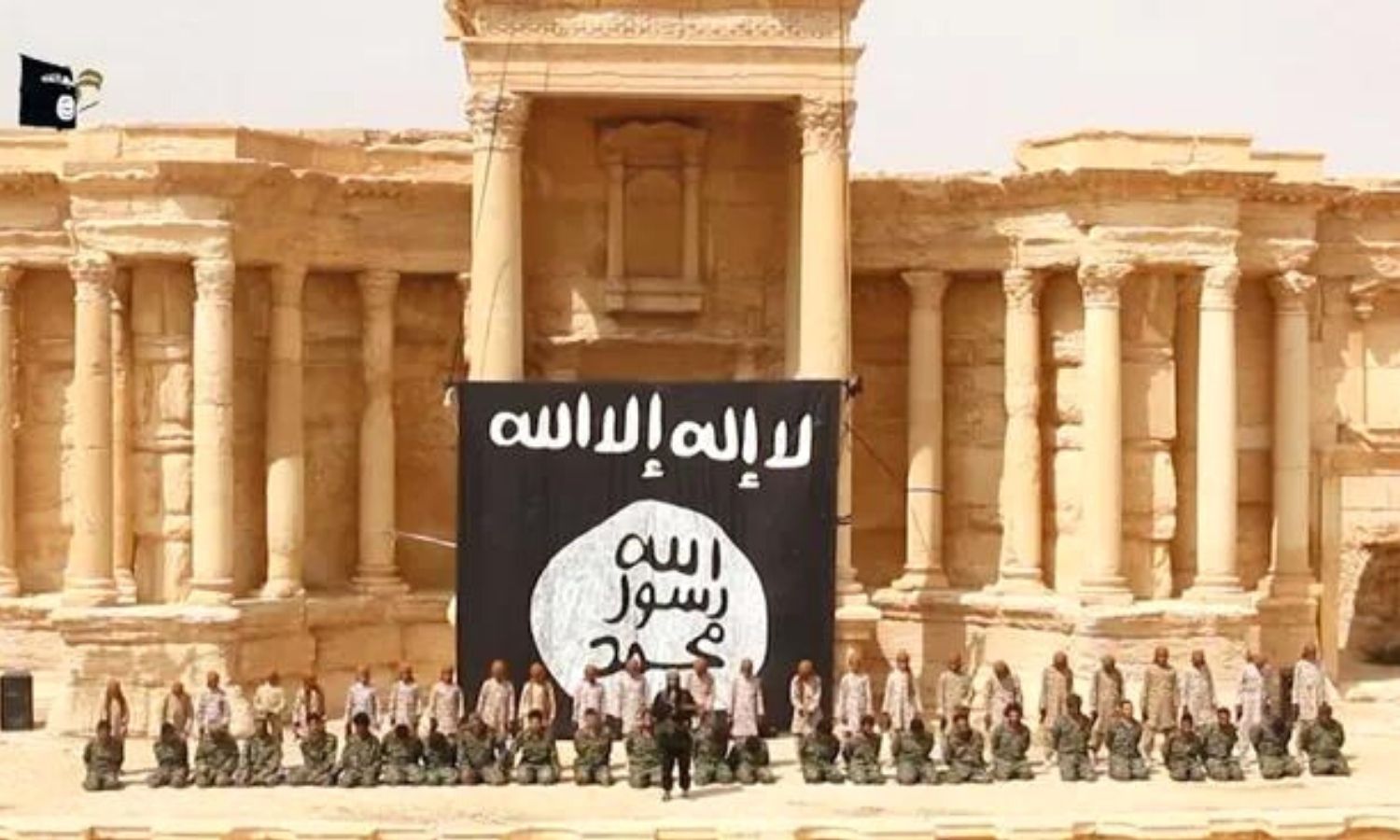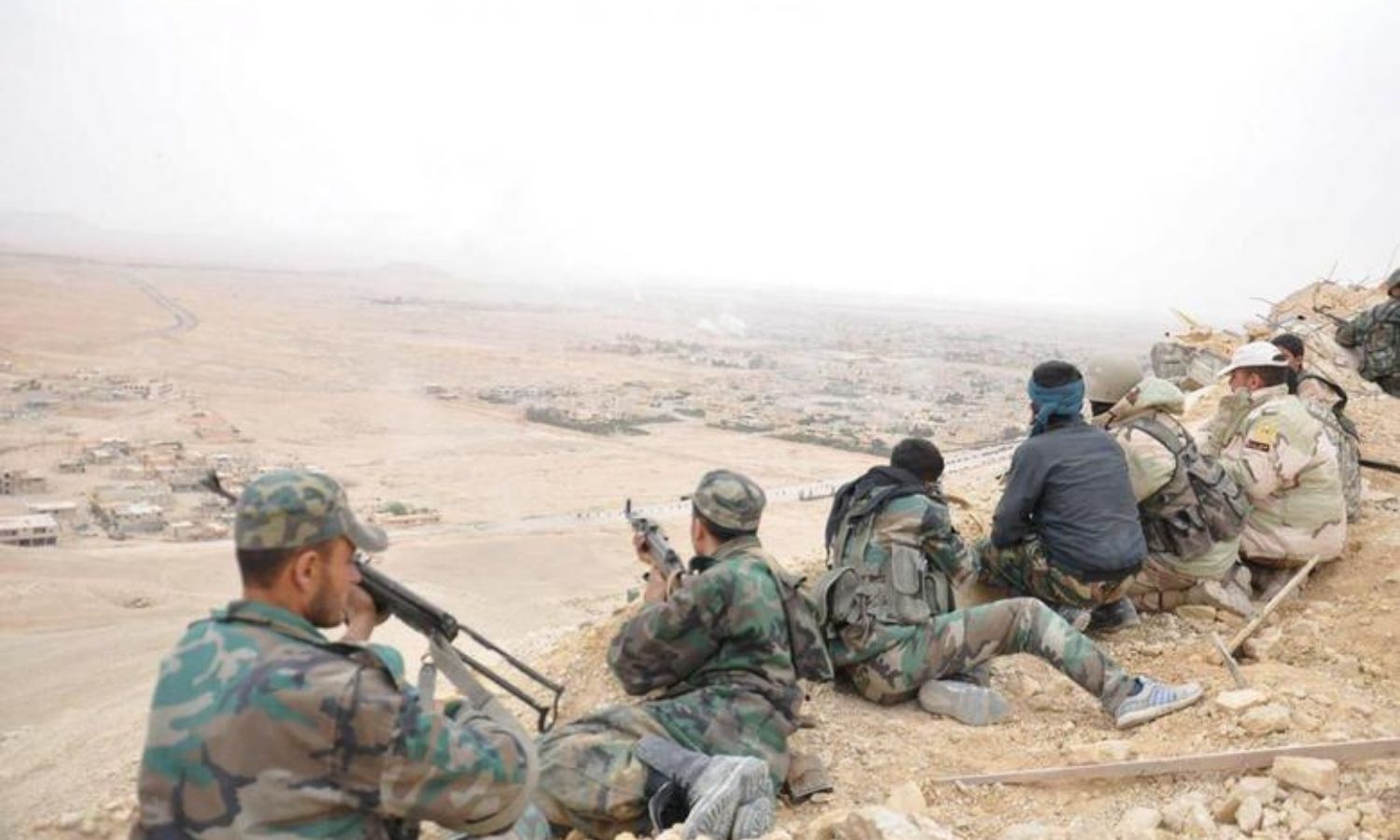



Enab Baladi – Hassan Ibrahim
“Mohammad wake up, wake up, the Islamic State’s fighters are in the neighborhood.”
Mohammad still feels terror and fear when he recalls the voice of his mother, who woke him up around 6 a.m. on the morning of 20 May 2015, at their home in the historic Palmyra city after the Islamic State (IS) controlled large swathes of the Syrian desert.
The awakening of Mohammad, 28, with a crazy heartbeat to the screaming of his mother was an alarm that extended for seconds, without thinking at the time that a disaster had occurred, and a feeling engraved in the memory of the man and his family for years, about what happened in the city.
Mohammad’s feelings of anxiety and fear mixed at that time, and that was days before the secondary certificate exam. The eastern neighborhood of the city in which Mohammad’s family resides, adjacent to the al-Fundok (the hotel) checkpoint of the regime forces, became empty after the residents moved out of it to further neighborhoods.
The military movement of the Syrian regime forces, Iran-backed popular committees, and the tribesmen of the Shaitat clan was not stable between 14 to 18 May 2015 in the city of Palmyra after IS maneuvered with several strikes and attacks on the northern countryside.
Fear and anxiety spread among the people of the city, as some houses became gradually emptied of their residents, and Mohammad’s family was the only one who did not leave their home in the eastern neighborhood, and news came of the control of the Islamic State group on the outskirts of the city.
“Do not worry, we are here.” With these words, one of the Syrian regime troops at the al-Fundok checkpoint answered Mohammad’s question about what was happening and if there was an emergency that required his family to leave the city.
Mohammad, whose house is about 100 meters from the checkpoint, approached the troops after he saw on the evening of 19 May 2015 the al-Shaitat tribesmen with their weapons in the streets of the eastern neighborhood.
Umm Mohammad closed the door of the house to the members of her family, and the air was filled with dread. Then, on 20 May of that year, Mohammad woke up to the turbulent voice of his mother to see the fighters of the Islamic State group enter the city without any resistance.
The neighborhood, which was empty at night of its residents, seemed to be full of IS militants, and black banners climbed the al-Fundok checkpoint, and shouting began to spread throughout the city.
“The scene was as if it were pictures from a Hollywood movie, in underwear and without weapons,” Mohammad described the fleeing regime forces in the Palmyra Central Prison area, which is about 500 meters away from his family’s home.
IS fighters were dispatched at the entrances to the city and in the main streets, and they set up checkpoints and patrols.
IS patrols began a decapitation drive in reprisal acts against regime-affiliated elements and civilians, carrying pre-made wanted lists.
SUVs also began roaming Palmyra’s streets, chasing the fugitives and searching inside the houses “without judicial courts or accountability. People with registered names were summarily killed by beheading, and whoever hid any member or person wanted by IS faced a similar fate.”
IS elements cut off the communications network in the city and removed the barriers and earth mounds that the regime had built, and the decapitated heads remained throughout the city for three days.
IS adopted many mechanisms and methods of killing, most notably the “beheading,” according to a well-established belief that was followed by the group’s legislators and applied by the militants.
“I felt lost between the fear for my children who were with me and for my husband who was missing.” After a silence that lasted for a few minutes, Umm Mohammad described to Enab Baladi her feelings of confusion in those moments, between fear for the five family members and anticipation while waiting for any news about her husband’s fate, who used to work in a government department in the agricultural sector, with a weekly shift system, and no news of him came after IS entered the city.
Umm Mohammad expressed her sorrow for the condition of the people who waited for deliverance from the regime’s oppression and arrogance, only to move to a new, more severe injustice.
At 12 p.m. on 20 May, it was the first time that the people of Palmyra knew what it meant to be bombed by the regime’s air force after it had bombed a car park in the eastern neighborhood, killing four people and causing great material damage. Electricity and water were cut off from the city, and the people resorted to basements of homes to escape death.
A week after IS took control and the stench of blood that spread throughout Palmyra, Umm Mohammad recounted to Enab Baladi the most “terrifying and frightening” scenes, in which IS elements brought women and pushed them into the house next to her house, which belonged to a member of the regime forces.
The saying “weeping is of no use when death comes” expressed the condition of the captive women, who launched continuous screams and cried for hours inside the house crowded with women, to no avail and no rescuer to respond.
None of the city’s residents could say a word or ask about these women or their fate, Umm Mohammad added, “Fear ruled people, not reason, logic, or emotion.”
Mohammad was surprised by the answer of his neighbor’s son, Mazen, after seeing him carrying a PKS machine gun, even though he was unable to use it, after being asked about the purpose of carrying it, that the young man had found the weapon in one of the orchards in the eastern countryside of the city after the Syrian regime and its allies fled.
There were frequent cases of finding weapons left by regime elements after the IS group entered the city, whether in the streets or agricultural lands or even in garbage containers, according to Mohammad.
The astonishment that appeared on people’s faces was not hidden when it came to talking about the regime’s weapon that was left behind. The hangar of warplanes at Palmyra Military Airport, where the planes land, was full of weapons and heavy and light munitions of all kinds.
Ten days after entering Palmyra, IS blew up a symbol of the repressive Syrian regime, the Palmyra Military Prison, after rigging it with explosives, to turn the page of the famous prison, which witnessed several massacres against its detainees over the years, especially in the eighties of the last century, during the era of The former president of the regime, Hafez al-Assad.
The media office of what was known at the time as “Wilayat Homs” published that the Islamic State booby-trapped the prison’s surroundings and inside with tons of explosives after informing the surrounding civilians of the need to stay away from the area during the explosion, after which pictures were published showing the bombing of all prison facilities, and leveling it on the ground, to miss all its features.
Some of the city’s residents, whom Enab Baladi met, said that the Syrian regime deliberately transferred many detainees by bus to other prisons before IS took control of the city, and the Syrian Observatory for Human Rights documented the transfer of detainees before the Islamic State fighters took control of Palmyra.
The fall of the Palmyra prison caused an interaction among Syrians through social media, with stories engraved in the minds of some of them and other narratives they transmitted about former detainees in what they called “Syria’s Bastille.”
The Palmyra prison is located in the depths of the Syrian desert on the outskirts of the city of Palmyra, east of the central city of Homs. It was established in 1966 to be a military prison. Hafez al-Assad quickly transformed it at the beginning of his 1970 rule into a political prison that included thousands of Syrians.
In 1980, the regime forces, led by Rifaat al-Assad, carried out a massacre inside the prison, the number of victims at that time exceeded 1,000, according to international organizations, most notably the Human Rights Watch (HRW), followed by other massacres in the following three years, especially after the 1982 Hama massacre.
Mohammad’s father returned to Palmyra after an absence of about ten days after he fled from his workplace, fearing the danger of battles and the scourge that they would bring after the Islamic State stormed the agricultural establishment in which he works.
“Lost, I went out of my mind,” words with which Mohammad’s father described his condition after he fled from his workplace, and no news of his family could reach him, as he settled during his absence from the city in one of the Bedouin homes that scattered around the city.
“It was as if I was seeing the city for the first time” on 30 May 2015, Abu Mohammad said, describing the moment he entered his city as a stranger, with the eyes of an explorer and detective, and with a feeling of fear for the unknown fate of his family, which turned to happiness when he saw that they were fine.
Mohammad’s father and his family left the city after more than three months, with a heart filled with a sense of loss, while the voice of the captive women remains stuck in his wife’s mind until now.
Raqqa was the second destination for the family who suffered the scourge of what happened, then they went to Idlib, and finally, they settled in Istanbul, Turkey.
|
The ancient city of Palmyra is located in the central Syrian province of Homs, in the heart of the Syrian desert. It has great historical and strategic importance. Its history dates back to the Neolithic era. It is located 215 kilometers northeast of the Syrian capital, Damascus, in an oasis surrounded by date palm trees. Two mountain ranges overlook the city; the Aleppo plateau (the Palmyra mountain range) from the north and the southern Palmyra mountains from the southwest, and from the southeast, they overlook the Syrian Badia. Palmyra was rich in its geographical location at the intersection of several ancient trade routes and turned into a regional center that reached its peak in the year 260 AD, when its king, Odaenathus, defeated the Sassanid Emperor Shapur I. Odaenathus was succeeded in rule by Queen Zenobia, who revolted against Roman rulers, and expelled them from the city, and established the independent kingdom of Palmyra. Palmyra is one of the oldest historical cities in the world, and since 1980 it has been included in the UNESCO list of internationally protected historical places. |

The ancient city of Palmyra in the eastern countryside of Homs – 28 December 2014 (Enab Baladi)
Days after IS control, some of the people wanted or prosecuted by IS fighters went into hiding. They were accused of several charges, including fighting IS, joining forces affiliated with the regime’s army, or forming what is known as the Popular Committees.
The Islamic State was known to hold “repentance courses,” in which persons violating the rules and principles of IS were subjected to lessons and teachings at the hands of IS’ Shariah men.
About 15 days after the Islamic State took control of Palmyra, Mahmoud Ghrayyeb, a member of the Popular Committees in the city, surrendered to the IS to undergo a “repentance course.”
Several days later, IS elements brought Ghrayyeb and some of the people who surrendered to the IS fighters, blindfolded, next to the Zenobia Primary school located near the public square in the city center.
They were placed in one row, with hands tied to their knees. The members of the Islamic State shot Mahmoud and those with him after removing the blindfolds from above their eyes, followed by running over the corpses that remained for three days in the street with one of the IS vehicles.
The Islamic State recruited children, opened offices called “Cubs of the Caliphate,” and prompted children to watch executions in public squares and even participate in them.
Hundreds of children have enrolled in IS schools after male and female teachers undergo Shariah courses.
In July 2015, the Islamic State released a video recording of the execution of soldiers affiliated with the regime’s army and allied forces, whom they had captured during the battles entering Palmyra.
The video, titled “Healing the Believers’ Chests,” was published by Wilayat Homs, as IS called it, on social media and showed 25 soldiers being taken from prison dormitories to the Roman Theater amid a noticeable presence of the city’s residents on the terrace.
The “cubs of the caliphate” children executed the kneeling troops on the stage of the theater by shooting them in the head, considering this as “God’s punishment for the Nusayris (Alawites) prisoners.”

“Cubs of the Caliphate” at the moment of shooting at regime troops and allied fighters at the Roman Theater in Palmyra – July 2015 (Wilayat Homs/ screenshot from a video recording)
The stage of destroying the antiquities in the Palmyra Museum began days after IS entered the city, and a statue of a lion was blown up at the museum’s door, known as the “Lion of Allat,” after the regime abandoned it due to its heavy weight.
In May 2015, the Syrian regime began transferring the antiquities of the Palmyra Archaeological Museum by helicopters, including mummies, antique paintings and stone statues, and everything that was light in weight, to the city of Damascus.
About three months after IS control over the city, IS members massacred veteran archaeologist Khaled al-Assaad, and hung his head on an electricity pole in the city’s archaeological square on 18 August 2015, after he refused to reveal and give IS information about the locations of artifacts.
Al-Assaad remained the head of the Department of Antiquities in Palmyra for more than 50 years, and he had several scientific studies published in a number of international archaeological journals on Palmyra.
He was known for his intellectual and religious moderation and contributed to the rebuilding of more than 400 entire columns of the arcades of the long street, the Temple of Baalshamin, the Temple of Allat, and the pillars, stage, and stairs of the theater. He also discovered in the ancient city of Palmyra 700 silver coins.
Al-Assaad worked hard to develop the archaeological institution in Palmyra scientifically and administratively. He has many well-known scientific books at the local and international levels. After his retirement, he worked with American, French, and German archaeological missions in excavations and research in the ruins and antiquities of the city.
Al-Assaad’s remains were found on 8 February 2021, and the regime’s media reported that the body was found in the Kahloul area, about ten kilometers east of Palmyra.
Russia entered the fight against the Islamic State in 2015 when it carried out its first airstrikes against it. The Russian intervention at that time was to support the regime in fighting IS and opposition rebel factions, which posed a direct and fateful threat to the Syrian regime and other parties on the ground.
After IS controlled Palmyra for ten months, the Syrian regime forces managed to regain control of the city in March 2016, with the support of the Russian Air Force, which changed the rules of the game in the battle through Russian airstrikes on the city.
The battles then moved to the areas of the eastern countryside of Homs in a hit-and-run way between IS and the regime army and allied forces until 11 December 2016, when IS announced its complete control over the city of Palmyra, amid battles that lasted for days.
At the time, Amaq agency, IS media wing, reported that IS fighters had imposed full control over the city at around 2:30 p.m. that day, and the control of the city came hours after IS announced its control over the ancient Palmyra Citadel.
“The Syrian army and the Shiite militias collapsed inside the city of Palmyra, with a massive attack by IS elements on their positions,” Amaq reported.
In March 2017, the Syrian regime’s media celebrated the restoration of regime forces with Russian support, the control of the city of Palmyra, and the expulsion of IS fighters from it.
The control of the city came with focused and joint air support from the Syrian and Russian warplanes.
The announcement of the regime forces’ control of Palmyra came after the Russian Defense Minister, Sergei Shoigu, informed the Russian President, Vladimir Putin, of the completion of the military operation in Palmyra.

Syrian regime forces on the outskirts of Palmyra city in the eastern countryside of Homs – 27 March 2016 (SANA)
Several forces, factions, and militias supported the Syrian regime in its battle against the IS group, relying on what was stated in loyal media accounts and matching them with IS news feeds, which are:
The Russian Army: The key supporter of the regime forces in the battle of Palmyra. Russia provided air cover for the military operations, and the officers planned and led the battle.
ISIS Hunters: A group of Russian volunteers in the eastern countryside of Homs, most of whom previously fought in the Russian army.
The Fifth Corps: Forces composed of Syrian volunteers, established in late 2016 with Russian-Iranian support.
National Defense: The first local auxiliary force established in 2013 to be auxiliary to the Syrian regime forces.
The Eagles of the Whirlwind: Forces affiliated with the Syrian National Party participated in the fight against IS in 2016 and 2017.
Al-Ridha Forces: A Shiite sect of fighters from loyal villages in the western countryside of Homs, whose members received training from the Iranian Revolutionary Guards.
Basij Forces: The Mobilization Forces of the Revolutionary Guards (Basij) is the most powerful Iranian army in Syria that participated in most of the battles of the regime forces in northern, southern, and central Syria.
The Fatemiyoun Corps: The Afghan fighters of the Fatemiyoun Corps came through reinforcements ordered by Tehran after IS recaptured the city of Palmyra and sent hundreds of them to fight in the city.
Imam Ali Brigades: Forces from the Shiite sect affiliated with the Iraqi Popular Mobilization announced their participation in the Palmyra confrontations under the supervision of the Iranian Revolutionary Guards.
Hezbollah: The Lebanese Hezbollah fighters participated in the Palmyra battles, and the advance was from the western axis of the battle.
The same forces and militias that participated in driving IS out of Palmyra are the same ones that contributed to the killing and displacement of a large number of civilians in various Syrian regions.
The International Coalition led by Washington began launching raids in August 2014 against the Islamic State, which controlled large areas of Syria and Iraq at the time.
Syria’s share was about 20,000 raids, and about 12,000 people were killed as of March 2019, including more than 2,000 children and about 1,300 women, according to the statistics of the Air Wars website, which monitors Coalition operations, in addition to the absence of some numbers about operations in which many civilians were killed.
With the passage of years, the military organization that was born from the womb of al-Qaeda and the Islamic State in Iraq moved from a clear and open geographical presence to launching its operations in separate geographical pockets, with the Syrian Badia being its most prominent arena, and the knot of rope that was not resolved by military operations and security campaigns led by various military parties in Syria for years.
After the retreat of its control in Syria, IS relied on the principle of targeting and then hiding, taking advantage of the geography of the Syrian Badia, which has a desert nature, and making it a theater for its security cells that target columns of the regime forces and the US-backed Syrian Democratic Forces (SDF).
The mechanism of movement and spread of IS sleeper cells and fighters in the Syrian Badia is still unclear, as the appearance of its militants is limited to moments of targeting, and then they disappear again in the desert.
The Syrian Badia extends from the eastern countryside of Hama and Homs to the Iraqi border and from the countryside of Deir Ezzor, and Raqqa in northern Syria to the Jordanian-Syrian border, and its area is more than 75,000 km² out of Syria’s area of about 185,000 km².
IS is still claiming responsibility for sporadic attacks targeting the regime forces or the Kurdish-led forces.
On 25 April, local networks said IS fighters had targeted a vehicle belonging to the SDF on the road to the town of Kabash, northwest of Raqqa, killing and wounding six patrol members.
IS claimed responsibility for the bombings that hit the Der Khabeyah town in the countryside of the city of Kiswa, south of the capital, Damascus, which left a number of casualties.
IS’ announcement on 16 May, stated that a cell affiliated with it detonated two explosive devices with two vehicles belonging to the Syrian regime forces in the town of Der Khabeyah. In a statement, IS said that two regime forces were killed and one wounded in the attack.
if you think the article contain wrong information or you have additional details Send Correction